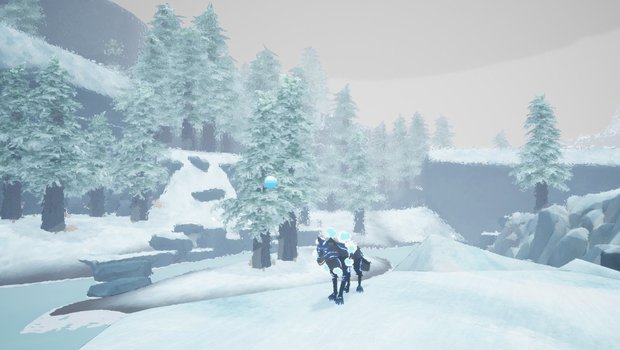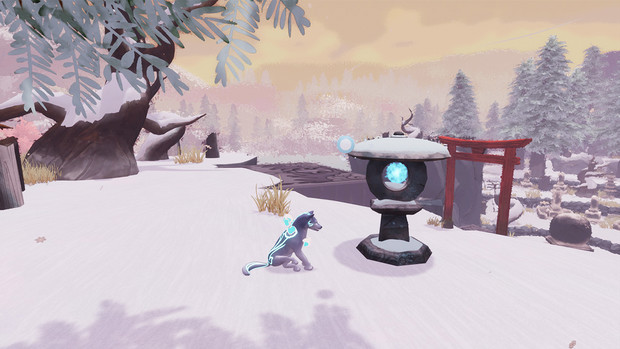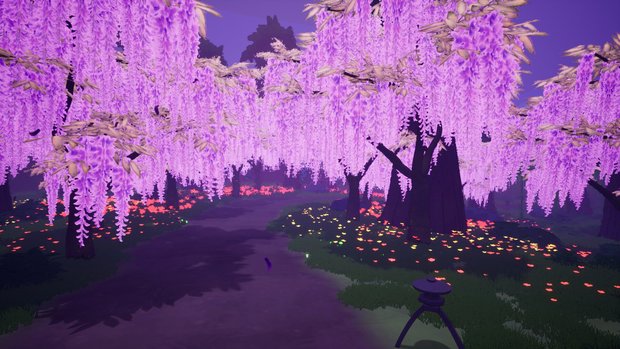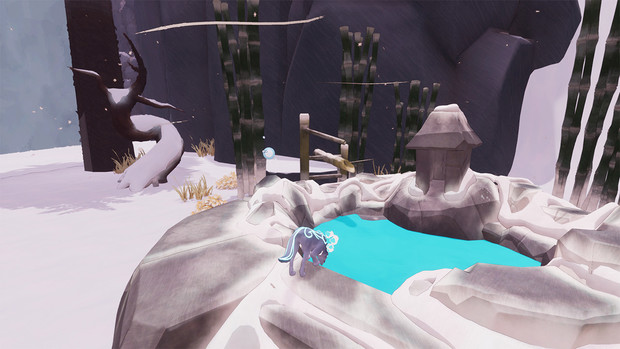Path of Kami: Journey Begins review

- 1 Comment
Short introductory spirit wolf adventure is more beautiful style than substance
What is an adventure game?
That’s a hard question to answer. We fans have been discussing (arguing) about this for decades now, but I would humbly offer that adventure games are generally defined by three fundamental concepts: exploration, puzzles, and story. What makes this such a great genre is that every game balances these three things – or at least two of them – differently, and that is what gives us such a wide variety of experiences.
Path of Kami: Journey Begins, however, really only has the exploration part of this formula, with very few puzzles and no story to speak of. But it does look great and has a really interesting narrative idea. Kazeyo, a Japanese wolf who died in the harsh winter, must now make the journey from the mortal world to the spiritual realm to become a spirit god. Unfortunately, it’s a let-down that there is simply no more depth than that. It really is just the beginning of a journey, presumably leaving the most compelling parts of this adventure for a bigger, deeper future game.

This is a game without a plot. In fact, I would go so far as to say that this is barely more than a glorified walking simulator. And even very little of the backstory is revealed within the game; instead it can only be garnered from the Steam page and from the DLC “Lore Book” you need to pay extra for. It’s a bit rich to create a game where the player is expecting to be immersed in the world, and then be charged extra to understand anything about that world. Not to mention that having to read a book outside the game for necessary information is a very poor design choice.
Why does this matter? Because the largest amount of context you’re given is in the opening scene where Wisp, literally a wisp (a ball of blue/white light) that hovers over your spirit wolf persona, gives you little more than vague directions. Upon starting the game, the conversation goes like this: “Kazeyo? Kazeyo, there you are. I’m sorry if I frightened you. This form is a little unnerving, I know. You can call me Wisp. I’m something of a guardian spirit. I’ll explain along the way, but we can’t stay here for long.”

And with that abundance of knowledge, you set out on your way. Other than those introductory lines, and a later encounter with another spirit wolf who gives you some more (still very) vague clues as to the purpose of your journey, along with the very occasional piece of information revealed during your exploration, there’s really no narrative to speak of.
As its subtitle suggests, Path of Kami is a journey – a rather short one. You simply want to get from your starting location, Evergreen Seas, to your final destination, and to do so you have to travel through a number of different areas. Each location is pretty much self-contained, and you can’t progress until you have found an item to unlock the path to your next destination. You could charitably call these puzzles, but the task is always the same: locate Spirit Keys scattered throughout the region and strategically place them in designated spots. Upon completing your task, you will be rewarded with an item that serves as a catalyst for advancing further.
Wisp serves as a tutorial of sorts to help you master the most common actions you’ll be undertaking, but the keyboard/mouse controls are appropriately simple to use: WASD for free movement through the world, the space bar to make Kazeyo jump, and the mouse to change the direction of the camera.
There will be times where your progress seems impeded, but there are always lanterns nearby. These lanterns, once you light them with Spirit Fire, reposition themselves or elevate platforms, allowing you access to different places. Sometimes the platforms will let you reach hidden areas, where there are collectibles to find. They’re not useful in-game but do unlock Steam achievements.

You possess a finite amount of Spirit Fire at any given time, designated by a ring of glowing circles around your neck. Using the left mouse button will send that Spirit Fire to a lantern to light it, while the right mouse button will bring it back to you, snuffing the lantern back and undoing all its effects in the process. Sacred fountains dot the landscape, offering a means to replenish your Spirit Fire in the rare event that your supply dwindles entirely. Even if you don’t need a refill, these fountains also serve as save points, and in the unfortunate event of your demise – usually by falling into water – you will respawn at the last fountain you entered.
At one point you will come across a sacred fountain, emptied of its magical waters, which feels like something different, yet the solution follows the standard puzzle formula: find a lantern and light it. Beyond that, your task is simply a matter of locating items to pick up by running over them, then using them in the correct locations to unlock the obstacle in your path. You can only pick up one item at a time, which appears in the mouth of Kazeyo until you drop it in the correct location. Usually this is as mundane as a locked door that needs a Spirit Key (sometimes this is literally a key and sometimes an idol or trinket), but one puzzle that serves as a transition between two areas is a cable car, inaccessible until the correct items are found and placed.

Where Path of Kami excels is in the graphics. This open 3D world is drawn with an artistic and painterly flair, and each location is impressive. In a world obviously inspired by Japan, the areas all look different and unique. The opening regions are snow-covered landscapes filled with mountains, rivers, and waterfalls, with ruins of Japanese-styled villages and monuments dotting the landscape. One place you encounter on your journey is indoors and has a lot of wooden-beamed tunnels to walk down and bridges to cross, while another is forested with green grass and brown dirt, mountains drawn in pink and purple hues, and giant canopies of red tree leaves overhead and in the distance. Vivid colours are also seen in luminescent purple trees and scattered flowers of red and yellow on the ground.
The advanced settings offer a wide variety of options, including adding reflections on the ground, shadows, and increasing the draw distance on the horizon. One major option is anti-aliasing, which when turned off (which I recommend) draws all the backgrounds in a painted mode, with rough edges that bleed a little into each other like watercolours would on a canvas.
The animations are few and far between, outside of Kazeyo as the main character. The wolf is well-animated, running, walking, and jumping smoothly, while gaining and losing Spirit Flame also works nicely and looks like the wolf is roaring. Wisp follows after you as you move, sometimes falling off-screen as you run forward but floating back to hover over your head when you stop. There are some evil spirit wolves you will encounter near the end of the game, animated similarly to Kazeyo, but the only other movement is found in the platforms as they rise or move, and again, this is serviceable with no complaints.
Musically, the game also delivers with a soundtrack that is heavy on the synthesiser, with some guitar and occasional bird sounds. The score provides a haunting atmosphere that perfectly matches the bleak and empty landscape, and the premise of a spirit wolf on its final journey. My only complaint is that there are only a handful of different musical tracks, and if you spend too long in one area, it becomes repetitive.
Final Verdict
As much as I loved the background art and appreciate the kernel of a story idea, Path of Kami: Journey Begins simply lacks too much to stand on its own. It’s clearly meant to be the precursor to a larger tale, but on its own I found it beautiful but boring for the most part, with the whole journey taking a little more than two hours from start to finish. All the objectives are virtually the same, and after I realised that fact I quickly lost interest, with not nearly enough new narrative details introduced to revive it. For some people, the relaxed walking simulator style of gameplay, taking the time to simply explore a lovely looking world with only the mildest of challenge to overcome, may be the perfect way to spend some time. For me, I just wanted to go back to the cave Wisp found me in, curl up, and go to sleep.
Hot take
With no story or any real puzzles to speak of, Path of Kami’s prologue will hold little interest for more hardcore traditional adventure game players, but the beautiful graphics and music do create an interesting world to explore at your leisure, if you think that alone will be enough to keep you interested for a couple hours.
Pros
- Excellent painterly background artwork
- Nicely scored soundtrack helps build a suitably melancholy atmosphere
Cons
- No story to speak of
- Minimal “puzzles” that all basically have the same simple solution
- Needs the separate DLC book to understand the world you’re exploring
Shawn played Path of Kami: Prologue on PC using a review code provided by the game's publisher.











1 Comment
Want to join the discussion? Leave a comment as guest, sign in or register in our forums.
Good and honest review. Too bad, it looks an interesting game indeed. And like you say, if you're just looking for something to relax your mind after a more challenging adventure, this might be just the ticket before setting off on another puzzle-filled journey.
Reply
Leave a comment